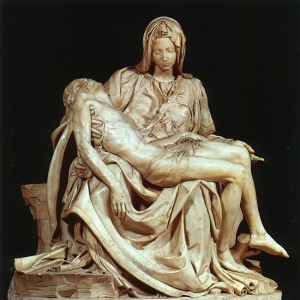This post introduces a new category on this blog, “My Shakespeare”. I borrow this name from Marina Tsvetaeva’s essay, “My Pushkin”, which impressed me very powerfully as a girl (and Pushkin is, in a sense, the Russian counterpart to Shakespeare, albeit much closer to us in time). In this first post, I will try and begin to approach the core question – what is it all about?
Marina Tsvetaeva begins her story with a very early childhood, when she first met Pushkin, in the form of a monument, in the park where her nanny used to bring her, and her brother and sister, for walks. She didn’t even know then that “Pushkin” and “monument” were two different words; as so often happens with small children, the words were glued together, unanalyzed, as a single concept. The monument was very, very large and very, very black; and as such, it was in a stark contrast with a small white doll she used to bring with her. She recalls comparing their contrasting sizes with her own self, and thinking that however many of such dolls one might put together, one on another, one wouldn’t get a Pushkin-monument. And even a hundred, or a million, such dolls together wouldn’t make one me, she thinks to herself; but – with a pride – maybe, just maybe, a hundred of me, put one on another, might just make one Pushkin-monument! The very concept of building such a tower out of one’s self must have made a powerful impression on me, because isn’t it what I am striving to do here, when all is said and done?
But what I really wanted to tell you about is a somewhat later memory, when she was about to see a sea for the first time in her life; she knew that her name, Marina, referred to sea, and she was in love with a poem, by Pushkin, about sea. The poem’s rhythms and words were so powerful, so magically enchanting, that she expected to be overwhelmed by her own, “real life” meeting with a sea – but the actual impression was nowhere even close to the image created by the poem in her mind. And so Pushkin’s sea, the one embodied and enacted in his poem, remained the real sea, even as she later learned to love “geographical”, real-life seas herself.
Why have I chosen Michelangelo’s Pieta as the image for this post? Because there is a distinct affinity, in my mind at least, between Tsvetaeva’s sea and Michelangelo’s grief of a mourning mother. At the time this sculpture was made he was in his early twenties – a boy, really; there was simply no way he could have known the feeling he so powerfully conveyed here from personal experience. And yet he had to know it – otherwise, this work would have been impossible. Where from? One theory argues that it was from “The Divine Comedy”, but whatever specific sources might have been, I have no doubts whatsoever that he got it from the ocean of Art, and made it his own – so much so that he could express it in this nearly unbearably real way, and thereby share it further.
(To be continued…)
